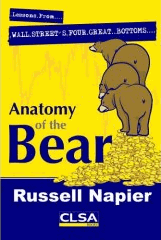Trading Lessons & Worden TeleChart
February 8, 2007 at 10:20 am
In my previous post, I discussed the importance of learning from our trading mistakes to become better traders, citing one way we learn at TheStockBandit.com is through the Trade of the Week lesson. In this post, I want to show you a way to learn more from trades of your past – by keeping them separate and tracking them in TeleChart.
I’ve been a user of TeleChart since 1999, and I’ve never regretted paying for this great product. I talk a lot about the importance of using a charting program if you’re an active trader (an absolute MUST!), so I’ll leave that for another discussion (even though I still believe it!). What I want to point out here is how to use TeleChart to learn from your past trades, so let’s get to it.
Learning From Others
At 7pm ET after every market close, I do one last update of TeleChart for the final end-of-day data. I use their real-time charting service, called Platinum (find me on TCNet anytime, I’m TheStockBandit), so when the market closes I already have the ending numbers for the day. However, there are occasional minor changes in data from the exchanges after the closing bell, so the 7pm update includes the official closing levels and volume totals.
The 7pm update also includes an incredibly underrated feature – The Worden Report from Don Worden. Don has been in the market for many decades, and his trading experience is most likely greater than yours and mine put together. His nightly report alone is worth the price of their software, and I rarely miss his posts to see how he is viewing the current market conditions. In addition to his post, there are often trading lessons provided via submitted notes from other TeleChart users to Don, along with his response to them. While many of these contain over-complicated formulas for locating trade ideas which I ignore, there are some real gems that show up when other traders share their own trading lessons.
One recent idea was submitted by Sir Fertile Sources, who suggested something revolutionary yet unbelievably simple: create a separate watch list for stocks you have sold! Soon after, Sir Major Lessons added another layer to the idea by creating separate “sold” watch lists depending on the conditions which generated the sale (abysmal loser, stop loss hit, stop loss hit for a gain, booked substantial gain). The idea is to be able to quickly review those stocks which you have held and see not just how they are doing now but also how you may have improved upon your exit.
TeleChart Notes
The Notes feature in TeleChart is highly underrated. Pull up any chart on any timeframe within TeleChart and click ‘N’ on the keyboard. A dialogue box pops up with an instant capture of the chart as it looks right now. Enter your thoughts (the note) and click ‘OK’. You’ve just made a note which will forever be tied to the current chart view, allowing you to return at any later date and review your note. This is perfect for the “sold” watch list…..once you’ve sold your stock, simply enter a note, save it and move on. Later when you want to review it, you’ll see exactly what you saw when you made your sale, giving you an instant visual comparison to the current chart.
 Notes are a one-click feature of TeleChart, allowing you to capture the chart and store your thoughts along with it. (The actual window can of course be resized).
Notes are a one-click feature of TeleChart, allowing you to capture the chart and store your thoughts along with it. (The actual window can of course be resized).WatchList Tracking
The WatchList Tracking feature of TeleChart is often overlooked. This is an excellent way to track a portfolio or even just a WatchList such as the “sold” WatchList. WatchList tracking will do exactly what it says – track every individual component in the list and even provide averages for things like percent change and number of days. This is ideal for the “Sold” WatchList, as the program will immediately and automatically begin to track your old stocks and you’ll be able to pull them up at a glance at any later date to see how well or poorly they have performed since your exit.
Keeping it Simple
Every trader who is looking to improve can find great lessons in trades of the past. Trading can get real complicated if you let it, so take the easy approach to improvement when you have the chance. This new learning approach is already simplifying how I review my trades, letting me get to the application of lessons much faster. I hope it works for you just as well!
Take a free 30-day trial of TeleChart 2007 and see what it can do for your trading. I did, and I’m still using it 8 years later.
Jeff White
President, The Stock Bandit, Inc.
www.TheStockBandit.com
[tags]Stock Market, Investing, Stock Trading, Stock Charts, Chart Patterns, TeleChart, Worden[/tags]
Learning From Trading Mistakes
February 7, 2007 at 10:15 am

Bob trades online so his dumb mistakes remain anonymous.
While I’m not a backtester, I do believe that we can learn a lot as traders by reviewing our trades of the past. After all, if we can’t learn from our mistakes, how can we learn at all?
The member area of TheStockBandit.com has a feature called “Trade of the Week”. It’s a useful area that a lot of members comment on due to the lessons taught there. The T.O.W. is a look back at a trade I took each week and how it turned out. Some of them work beautifully and I get to brag a little, but the ones that we all learn from the most (myself included) are the losing trades which are dissected after the fact.
JAH is one trade I recently featured, which was a channeling stock I took for a short sale at an area of resistance. My stop loss level was close by and the stock had bounced on diminishing volume right up to the upper channel line. I went short, but the stock soon after broke above the trend line, triggering my buy stop to take me out of the trade for a small loss.
After examining the trade closely, I determined that if I were given the same setup again, I’d trade it again the same way. I just like these setups because in every case my risk is quantified with a good potential reward, and that’s the cornerstone of how I trade. However, in this case I was objective and this was one trade in which my timing was simply off. Sometimes the lessons are minor, but being willing to take something away from a closed trade is the mentality we need.
It always surprises me how even selecting just one trade per week to examine more closely helps me learn and apply that lesson better going forward. Over the course of a year, I end up being a lot smarter as a trader.
What are you doing to learn from your trading mistakes? In my next post, I’ll show you a great way to learn from your past trades which is so simple you won’t believe it.
Until then, trade well!
Jeff White
President, The Stock Bandit, Inc.
www.TheStockBandit.com
[tags]Stock Market, Trading Profits, Profit Targets, Stock Trading[/tags]
Proper Positioning for Traders
February 7, 2007 at 9:26 am
Toddo wrote a great article over at MarketWatch that I highly recommend reading. His 5 points of proactive thoughts on how to position yourself properly in today’s market is a quick read that we all stand to benefit from. Check it out, even if you only skim!
Jeff White
President, The Stock Bandit, Inc.
www.TheStockBandit.com
[tags]Stock Market, Day Trading, Stock Trading, Investing, Swing Trading[/tags]
Realities of Trading
February 6, 2007 at 12:07 am
Hope your trading is off to a good start this week!
Wanted to give you a heads-up on this week’s free newsletter over at TheStockBandit.com for my thoughts on 3 very basic but important realities of trading. I feel strongly that the acceptance of these principles can not only smooth out the equity curve of any trader, but also the psychological impact which trading can have at times.
And by the way, you can sign up for the free newsletter on the Free Newsletter page at TheStockBandit.com. An opt-in form is provided at the top of the page which puts you in full control of your email subscription at all times.
Trade well this week,
Jeff White
President, The Stock Bandit, Inc.
www.TheStockBandit.com
[tags]Stock Market, Day Trading, Stock Trading, Investing, Swing Trading[/tags]
Trading Intentions vs. Trading Actions
February 1, 2007 at 9:46 am
We’re all weak from time to time! Even the most disciplined suffer from moments of weakness. But, it’s how we learn from those moments that will determine our growth.
Case in point: The other day I was heating up some leftovers from Macaroni Grill. It wasn’t enough for 2 servings, but it was more than 1 serving and I knew it. I just decided to heat it all up, intending to eat what I wanted and leave the rest. Yeah, right!
Next thing I know, I’m down to the last few bites from what was originally a huge plate of food! What happened? I love to eat good food but I’m no Kobayashi! I surprised myself with what I put away, but it’s easy to see how it happened. When I loaded up the plate to begin with, I left the door of possibility wide open.
They say if you make decisions ahead of time, that once it comes time to make a critical choice you will make the right move. I failed to do that with my Macaroni Grill leftovers, and you know where I’m going with this — Trading!
I’ve done it too many times and the odds are that you’re familiar with it too. That trade you never intended to let get away from you just somehow managed to get too big. What started out as a 2 or 3% loser just seemed to snowball and before you blinked you were staring at a 15% loss. Ouch!
Bad News First
The bad news is that as humans, we’re prone to mistakes and that means repeat offenses. We might not have it within ourselves to keep a mental stop and act on it when we should. Blame it on not paying attention, blame it on a slippery market maker, you can even Blame it on Mexico if you need a reason, but the truth is that failing to put our original intentions into an actionable plan is what can make a bad trade even worse.
Preventing Pain
You aren’t alone, every one of us have let trades slip away when we shouldn’t have. The good news is that it’s fixable, and that means it can be avoided (unless the stock gaps big against you). It’s so simple, but yet easy to forget or ignore. Don’t fall into that trap.
It’s your money, so be vigilant! Set your stop loss as soon as you get filled on your entry, and trail it higher as the trade progresses so that you can let your profits run. Personally I do this with conditional orders through CyberTrader because they let me specify exactly what needs to happen to trigger an exit, but even a plain-Jane stop loss will do the job better than a mental stop, so use whatever tools you have at your disposal and turn your trading intentions into actions!
Jeff White
President, The Stock Bandit, Inc.
www.TheStockBandit.com
[tags]Stock Market, Stock Trading, Day Trading[/tags]
Profit Targets: One or Two?
January 29, 2007 at 11:34 pm
I am a big proponent of planning trades as thoroughly as possible before getting in. I prefer to set my stops in one place and exit the trade all at once if I am wrong, but taking profits is another topic. At times, one profit target makes sense. Other times call for multiple profit targets.
Check out this week’s free newsletter over at TheStockBandit.com for my thoughts on planning profitable exits. And by the way, you can sign up for the free newsletter on the Free Newsletter page at TheStockBandit.com. An opt-in form is provided at the top of the page which puts you in full control of your email subscription at all times.
Trade well this week!
Jeff White
President, The Stock Bandit, Inc.
www.TheStockBandit.com
[tags]Stock Market, Trading Profits, Profit Targets, Stock Trading[/tags]
Book Review: Anatomy of the Bear
January 29, 2007 at 11:00 pm
 I love to read trading books, so when I was asked to review Russell Napier’s book, Anatomy of the Bear, I happily obliged.
I love to read trading books, so when I was asked to review Russell Napier’s book, Anatomy of the Bear, I happily obliged.
In the book, Napier examines 4 major bear market bottoms on Wall St., with a portion of the book devoted to each of the major lows created in 1921, 1932, 1949 and 1982. Napier looks at the history of these bear markets, the events leading up to them, and how the investors of those times were impacted throughout the bottoming process. In his research, he examined some 70,000 articles from the Wall Street Journal from the two months before and after the final lows were made, adding some valuable perspectives from the media and traders of the day. These article tidbits give some great insights into life in the trading trenches at the time, which is incredibly helpful in painting the picture of the doom and gloom which ultimately accompanies a lasting market bottom.
Napier also takes the reader back to the situations of each of the major lows, essentially transporting you to the time and the events which led up to the bear phases. He examines wars, monetary policy, politics, economic factors, and anything else which had an impact on the buying and selling motivations of traders, making this book an incredible resource for anyone wanting to learn from lessons of the past.
Here are a few things I found noteworthy:
* Earnings Trailed Price. In the 1921 bottom, price found a low about 4 months before earnings found a bottom. Earnings bottomed some 5 months after price bottomed in the 1932 bottom. That makes for some interesting fundamental vs. technical discussion! (You know which side I’m on)
* Short Interest Stayed High After Lows. Napier discovered that short interest remained rather high even after price made a low, serving as a good reminder that even bears get greedy. In turn, as the shorts end up having to buy to exit their positions, it propels prices even higher, perpetuating the newfound momentum. Napier notes that a large short interest combined with a market that didn’t decline on bad news was an excellent signal in the 1921, 1932 and 1949 lows.
* Bear Markets Don’t Scare You Out. The results of Napier’s research flies somewhat in the face of theories which indicate that capitulation marks a lasting low, revealing instead that bear markets typically end with a final decline on no volume. Essentially, bear markets wear you out, not scare you out.
* Commodities Count. The end of commodity price declines also marked all 4 major equity lows, with copper playing a prominent role as it preceded or coincided with every equity rebound.
The book also ends with a great number of strategic and tactical conclusions drawn from the study of these 4 great bear markets – plenty of reason alone to check out this book.
Thanks to Russell Napier for the chance to review this fine study of the past, I enjoyed the read and learned a great deal from the bear markets of the past.
Jeff White
President, The Stock Bandit, Inc.
www.TheStockBandit.com
[tags]Stock Market Books, Bear Market, Stock Market Lows, Russell Napier[/tags]





